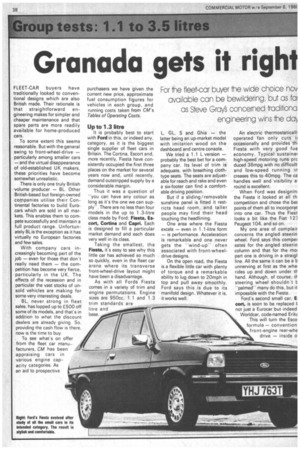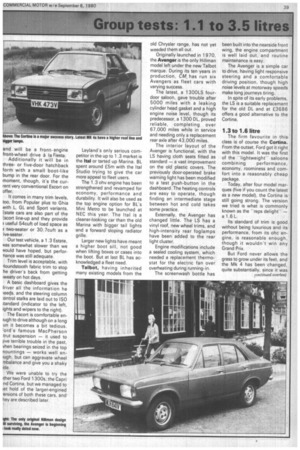Granada gets it right
Page 40

Page 41

If you've noticed an error in this article please click here to report it so we can fix it.
FLEET-CAR buyers have traditionally looked to conven tional designs which are also British made. Their rationale is that straightforward engineering makes for simpler and cheaper maintenance and that spare parts are more readily available for home-produced cars.
To some extent this seems reasonable. But with the general swing to front-wheel-drive — particularly among smaller cars — and the virtual disappearance of old-established UK makers, these priorities have become somewhat unrealistic.
There is only one truly British volume producer — BL. Other British-based but foreign-owned companies utilise their Continental factories to build Eurocars which are sold in all markets. This enables them to compete successfully and maintain a full product range. Unfortunately BL is the exception as it has virtually no European factories and few sales.
With company cars increasingly becoming part of the job — even for those that don't really need them — the competition has become very fierce, particularly in the UK. The effects of the recession and in particular the vast stocks of unsold vehicles are making for some very interesting deals.
BL, never strong in fleet sales, has lopped up to £500 off some of its models, and that's in addition to what the discount dealers are already giving So, providing the cash flow is there, now is the time to buy.
To see what's on offer from the fleet car manufacturers, CM has been appraising cars in various engine capacity categories. As an aid to prospective Up to 1.3 litre
It is probably best to start with Ford in this, or indeed any, category, as it is the biggest single supplier of fleet cars in Britain. The Cortina, Escort and, more recently, Fiesta have consistently occupied the first three places on the market for several years now and, until recently, demand outstripped supply by a considerable margin.
Thus it was a question of
you can have any colour as long as it's the one we can supply-. There are no less than four models in the up to 1.3-litre class made by Ford: Fiesta, Escort, Cortina and Capri. Each is designed to fill a particular market demand and each does very well in its class.
Taking the smallest, the Fiesta, it's easy to see why this little car has achieved so much so quickly, even in the fleet car arena where its transverse front-wheel-drive layout might have been a disadvantage.
As with all Fords Fiesta comes in a variety of trim and engine permutations. Engine sizes are 950cc, 1.1 and 1.3 trim standards are litre and base L, GL, S and Ghia — the latter being an up-market model with imitation wood on the dashboard and centre console.
We tried a 1.1 L version — probably the best bet for a company car. Its level of trim is adequate, with breathing clothtype seats. The seats are adjustable for reach and rake and even a six-footer can find a comfortable driving position.
But if a sliding /removable sunshine panel is fitted it restricts head room, and taller people may find their head touching the headlining.
One area where the Fiesta excels — even in 1.1-litre form — is performance. Acceleration is remarkable and one never gets the -wind-upoften associated with front-wheeldrive designs.
On the open road, the Fiesta is a flexible little car with plenty of torque and a remarkable ability to lug down to 20mph in top and pull away smoothly. Ford says this is due to its manifold design. Whatever it is, it works well.
An electric thermostaticall, operated fan only cuts ii occasionally and provides thl Fiesta with very good fue economy. Typical sustainei high-speed motoring runs prc duced 36mpg with no difficult and low-speed running ir creases this to 40mpg. The ca handles well and visibility a round is excellent.
When Ford was designinl the Fiesta it looked at all th competition and chose the bet points of them all to incorporat into one car. Thus the Fiest looks a bit like the Fiat 12-, Peugeot 104, and so on.
My one area of complair concerns the angled steerin wheel. Ford says this camper sates for the angled steerin column and that for the mo; part one is driving in a straigt line. All the same it can be a b unnerving at first as the whel rides up and down under IV hand. Although, of course, th steering wheel shouldn't b "palmed" many do this, but it impossible with the Fiesta.
Ford's second small car, E coil, is soon to be replaced k not just a Eurocar but indeed Worldcar, code-named Erikz This will turn the Esco formula — convention front-engine rear-whe drive — inside o and will be a frontengine front-wheel drive 5 la Fiesta.
Additionally it will be in threeor five-door hatchback form with a small boot-like bump in the rear door. For the moment, though, it's the current very conventional Escort on offer.
It comes in many trim levels, too, from Popular plus to Ghia with L, GL and Sport variants.
Estate cars are also part of the Escort line-up and they provide
3 useful 54cuft of load space as 3 two-seater or 30, 7cuft as a lve-seater.
Our test vehicle, a 1.3 Estate, was somewhat slower than we would have hoped, but perfor/lance was still adequate.
Trim level is acceptable, with doundstooth fabric trim to stop he driver's back from getting ;weaty on hot days.
A basic dashboard gives the Inver all the information he teeds, and the steering column ;ontrol stalks are laid out to ISO ;tandard (indicator to the left, ights and wipers to the right).
The Escort is comfortable en}ugh to drive although on a long un it becomes a bit tedious.
'ord's famous MacPherson trot suspension — it used to jive terrible trouble in the past, vhen bearings seized in the top nountings — works well enugh, but but can aggravate wheel mbalance and give you a shaky ide.
We were unable to try the ither two Ford 1300s, the Capri
,nd Cortina, but we managed to let hold of the larger-engined ersions of both these cars, and hey are described later.
Leyland's only serious competitor in the up to 1.3 market is the hal or tarted up Marina, BL spent around £5m with the Rai Studio trying to give the car more appeal to fleet users, The 1.3 ohv engine has been strengthened and revamped for economy, performance and durability. It will also be used as the top engine option for BL's Mini Metro to be launched at NEC this year. The hal is a cleaner-looking car than the old Marina with bigger tail lights and a forward sloping radiator grille.
Larger new lights have meant a higher boot sill, not good when lifting boxes or cases into the boot. But at last BL has acknowledged a fleet need.
Talbot, having inherited many existing models from the old Chrysler range, has not yet weeded them all out.
Originally launched in 1970, the Avenger is the only Hillman model left under the new Talbot marque. During its ten years in production, CM_ has run six Avengers as fleet cars with varying success.
The latest, a 1300LS fourdoor saloon, gave trouble after 5000 miles with a leaking cylinder head gasket and a high engine noise level, though its predecessor, a 1300 DL, proved reliable, completing over 67,000 miles while in service and needing only a replacement rear axle after 43,000 miles.
The interior layout of the Avenger is functional, with the LS having cloth seats fitted as standard — a vast improvement on the old plastic covers. The previously door-operated brake warning light has been modified to a test push-button in the dashboard. The heating controls are easy to operate, though finding an intermediate stage between hot and cold takes some practice.
Externally, the Avenger has changed little. The LS has a vinyl roof, new wheel trims, and high-intensity rear foglamps have been added to the rear light cluster.
Engine modifications include a sealed cooling system, which needed a replacement thermostat for the electric fan over overheating during running-in.
The screenwash bottle has been built into the nearside front wing, the engine compartment is well laid out, and routine maintenance is easy.
The Avenger is a simple car to drive, having light responsive steering and a comfortable driving position, though high noise levels at motorway speeds make long journeys tiring.
In spite of its early problems, the LS is a suitable replacement for the old DL and at £3686 offers a good alternative to the Cortina.
1.3 to 1.6 litre
The firm favourite in this class is of course the Cortina. From the outset, Ford got it right with this model. It was the first of the "lightweight' saloons combining performance, economy, roominess and comfort into a reasonably cheap package.
Today, after four model marques (five if you count the latest as a new model), the Cortina is still going strong. The version we tried is what is commonly known as the "reps delight" — a 1.6 L.
Its standard of trim is good without being luxurious and its performance, from its ohc engine, is reasonable enough, though it wouldn't win any Grand Prix.
But Ford never allows the grass to grow under its feet, and the Mk 4 has been changed, quite substantially, since it was




































































































































